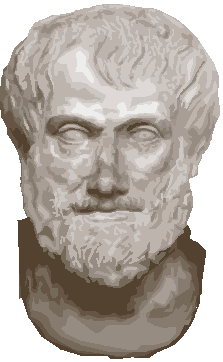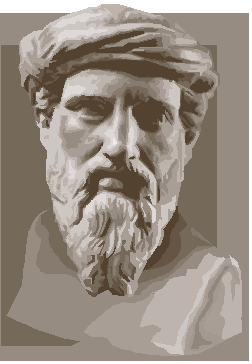

The Hellenistic Age is the period between the conquest of the Persian Empire by Alexander the Great of Roman supremacy, in which Greek culture and learning were predominant in the Mediterranean and the Middle East. Alexander the Great died shortly after the Hellenistic Age began. At the age of 32 and leaving no heirs, he died in Babylon in 322 B.C. (Woodford). His generals would divide Alexander's huge empire into three main Macedonian kingdoms: Egypt under the Ptolimis; Syria, ruled by the Seleucids; and Macedonia under the Antigonid dynasty. The urban elite in these kingdoms spoke common Greek and native elements. Many new cities were founded, most important of which was the Attalid at Pergamon. Along with the lands they ruled, came rivalries inherited by their descendents (Smith).
The third century of the Hellenistic world was a heyday politically and culturally. Relatively stable were the kingdoms in this period. Under the Hellenistic kingship, were economic power and an undiminished military and unusually creative were the elites of the new cities. Settlers, soldiers, and cultural prestige were needed for the new kingdoms (Smith).
Undre the Ptloemis, who used their wealth to attract poets, scholars, artists, and scientists, the city became a great economic, cultural, and religious centre. The religion of the Hellenistic Age combined Greek gods with Eastern deities. This was a process known as syncretism, or mixing of religions. The third century brought the Attalids, an enterprising and cultured dynasty. Several smaller kingdoms and some venerable Greek cities that were nominally free were also formed (Smith). In the meantime, the Attalids only showed appreciation and growing was the power of Rome (Woodford). The Hellenistic kingdoms that coexisted fought and competed with each other. As the Hellenistic monarchies declined in the second and first century B.C., the Romans gradually extended their control over Greece and the Middle East (Smith). Rome had absorbed the entire Hellenistic world into the Roman Empire (Woodford). In 30 B.C., Augustus extinguished the Ptolemaic kingdom which was the last to fall. The Roman civilization that subsequently became dominant was in many ways a continuation of Hellenistic culture (Smith).
Gone forever was the Hellenic polis' intimacy and independence. Men were now subjects and no longer citizens of a polis. The only sense of belonging was to themselves. The old cities in Greece were dominated by public buildings and extremely modest were the private homes which ranged from comfortable to luxurious. Monarchs, not the people build grand public monuments. A radical change to the temper of the times had taken place (Woodford).
The Greeks dominated the cities and from their homeland migrated many new settlers. These centres of higher civilizations quickly attracted the surrounding peoples. The greed of money went emigrant Greek thinkers, writers, and artists to seek profitable new employment with kings. As never before, often under royal patronage, literature, learning, and science in this pluralist world with a highly advanced urban culture flourished (Woodford). They inevitably broadened, distorted, and vulgarized the Greek culture while trying to absorb it. What can be already discerned in the fourth century B.C., are the new tendencies that developed in Hellenistic art (Smith).
Politically, Alexander and Augustus is the period that may be defined easily and early, middle, and late can be roughly divided. Alexander and the sucessors (320-270 B.C.) comprises the early period. The time of the established kingdoms (270-150 B.C.) is the middle period and to be first overshadowed before being dominated by Rome is the late Hellenistic period. In terms of chronology, to define or analyze Hellenistic sculpture is not easy, not even its beginning and end. Both in the Greek East and at Rome, some important features had appeared before Alexander and others continued long after Augustus. The statues produced for Hellenistic kings and the Greek cities before the Roman conquest we will concentrate on because this is the period in which surely created was the bulk of the new repertoire (Smith). back to top

Hellenistic Sculpture
Innovation did not exclude the Classical heritage. Sculptures continued in a Classical manner as a reflection of the unchanged needs of some sectors, notably in the old cities of Hellenistic society. In terms of quantity and expression, a great expansion of the existing repertoire was the basis for the innovations of Hellenistic sculpture. The colonization of the Greek and Macedonians in this great era resulted in the emergence of a society in the new cities of the Hellenistic East. They were more complex culturally and socially and also more cosmopolitan. This society had many new demands and also wanted statues of both Athena and Hermaphrodite. These new demands of a society by the conquests of Alexander the Great whose horizons had been vastly expanded had sculptors responding (Smith).
Hellenistic sculpture had to speak to a far more diverse audience, the stylistic unity that had characterized the art of Classical Greece down. For the same reason, Hellenistic artists tended to choose subjects that all people could readily understand, regardless of nationality or ethnicity. The Hellenistic sculpture shows some of its most distinctive achievements. In the Hellenistic period, a great range of figure styles of muscled heroes to plump putti were first produced. For the first time in major statues, sculptors increasingly and realistically depicted and explored regarding new states of body and mind that expressed a specific emotional or physical state, such as old age, anxiety, sleep, fatique, drunkenness, or even deformity. The decrepit, the miserable, the sensuous, and the ecstatic were also included (Smith).
The emotional favored by Scopas was heightened in statues of
exhausted boxers, dead or dying warriors, fierce giants, and amazons, and
decrepit old men and women. At the same time, Hellenistic sculptors developed
further some of the trends established in the Late Classical period. There were
figures of respective philosophers, satyrs, or Homeric heroes whose head and
body were designed to look lifelike and at first glance you could recognize
them (Smith).
and amazons, and
decrepit old men and women. At the same time, Hellenistic sculptors developed
further some of the trends established in the Late Classical period. There were
figures of respective philosophers, satyrs, or Homeric heroes whose head and
body were designed to look lifelike and at first glance you could recognize
them (Smith).

The most striking and enduring creations of Hellenistic sculpture were the philosopher portraits. The man of thought was an image that was defined usually sitting in a gesture of reflection by holding a hand to his chin. Sculptors created numerous nude or seminude Aphrodites, such as the famous "Venus of Milo" (also known as Aphrodite of Melos). It is also an era when numerous sculptors depicted the Hermaphrodite, a person equipped with both male and female sexual organs. The foremost qualities of Hellenistic sculpture are the variety, subtlety, and complexity (Smith).
Lysippus left perhaps the strongest legacy to the Hellenistic period. The personality portrait is one of the leading sculptural genres of a period that is notable for its images of generals, rulers, poets, and philosophers. Alexander the Great started and encouraged this concept of royal figures portrature and declared that he was to be regarded as a god. Sucessors and other royal figures would continue this idea. They would also use similar features such as having clean shaven faces, thick royal hair, dynamism, and portraying themselves as young heroes and gods by using the Late Classical repertoire. although vivid and lifelike, these sculptures, which portrayed determined and handsome youths, were frequently idealized images. The Hellenistic Age displayed remarkable naturalism and often expressed genuine emotion (Burn). In quantity for cities, sanctuaries, and royal capitals, royal statues were commissioned in bronze (Smith).
Emphatically public, were the Hellenistic statues as in the Classical period. In public buildings and in public spaces is where they were set up. A king or city often publicly commissioned statues. Statues were made as objects with a religious, political, or social function and not in the first instance for art's sake. Aesthetically, they were judged. For its dedication, a specific occasion and purpose was for each statue originally. Cult, votive, funerary, or honorific was one of the four functions that a statue could have. In this period, of these, honorific was the new and important category (Smith).
The image of a god in his temple was a cult statue (agalma). It is the specific place of worship of that god. The cult statue was a visual function that defined the local personality. Votive statues were dedications for anticipated or received divine factors. From state monuments to small terra cottas, votive statue's scale, material, and purchaser had a wide span range. These major dedications were placed in sanctuaries. Their function was professed religious, but frequently they were highly charged politically. Funerary statues were placed in the graves as memorials for the deceased. They were mostly of marble and were private commissions. Awarded by the state in gratitude for significant benefactions, honorific statues were portraits of prominent men. They were mostly made of bronze and placed in the agora, theatre, or in a sanctuary. To cope with needs beyond the state's collective resources, the number increased as dependence grew on prominent individuals. In thousands of inscribed decrees, the cycle of benefaction and honor is a familiar feature of city life recorded. The Honor's increased use became the principle product and a general connection between the rise of honorific statues and individualized portraiture in the early Hellenistic period (Smith).
A range of sculptural styles appeared during the Hellenistic period. There is too many to list. The Greeks were determined to achieve the desired look in their works of art. This demonstrates that Greeks continued to produce important sculptures during the Roman era. The Greeks were unique and remarkable. They endured hardships, wars, and vandalism. Yet, their works of art survived by being copied or repaired. Their sculptures tell us a story. Their way of thinking and living is how we as Westerners think and live today. We owe a great appreciation to them because if it wasn't for them we would not be a free and democratic society who too appreciates art the way the Greeks did. back to top


" Venus of Milo" "Nike of Samothrace"







